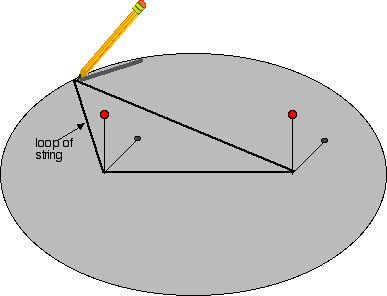Ellipses
You need to come to class on the indicated day with an ellipse prepared on a piece of binder paper.
- To make an ellipse, place your piece of binder paper over a piece of cardboard.
- Stick two tacks about 10 cm. apart.
- Tie a piece of string into a loop so that when placed over the tacks, you can stretch the loop with a pencil almost to the edge of your paper.
- Move the pencil as shown around the paper to make your ellipse.

- Line DG is the minor axis of the ellipse. f1 and f2 are the two foci of the ellipse.
- Lines CA and CB are the semimajor axes and lines CD and CG are the semiminor axes. Segment a is also a semimajor axis. Note that the foci are off center by distance ea.
- The ratio of ea to the semimajor axis is the eccentricity of the ellipse, e.
- The closer to the center the foci are, the smaller the value of e (the lower the eccentricity).
- When the foci are at the center, ea is zero, and the eccentricity is zero, and the shape is a circle.
- As the foci get farther from the center, the shape is more eccentric, and e is larger.

1. ![]() . For any particular planet, Gm1m2 is constant, and that means that Fg is proportional to 1/d2, where d is the distance between the planet and the Sun. Another way of saying this is that Fg is inversely proportional to d2. If we assign an arbitrary value of 1.0 to the Fg at location A in the orbit, how does the Fg at location B compare to that?
. For any particular planet, Gm1m2 is constant, and that means that Fg is proportional to 1/d2, where d is the distance between the planet and the Sun. Another way of saying this is that Fg is inversely proportional to d2. If we assign an arbitrary value of 1.0 to the Fg at location A in the orbit, how does the Fg at location B compare to that?
Since Fg is inversely proportional to d2, that means that if d decreases, the force does the inverse, or increases. Further, if d decreases by a certain factor, Fg increases by the square of that factor.
Example..
- In the case where the planet is at point B, the distance d between the planet and the Sun is f1-B. Let's make that value 12 AU.
- Then move the planet to point A where d (A-f1) is only 2 AU.
- By what factor has the distance d been reduced? 12/2 = 6.
- d is 1/6 of the value it had when the planet was at B.
- The force at A will be the inverse2 of this value, or (6/1)2 times the force at B. If Fg at B was 1.0, then Fg at A is 36.
- Remember again, no planetary orbits in our system are really this eccentric, and therefore the difference in forces between apogee and perigee are not nearly as great as in this example.